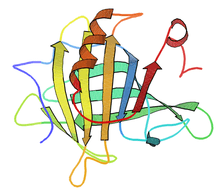Beta-lactoglobulin
β-Lactoglobulin (LGB) is the major whey protein of cow and sheep's milk (~3 g/l), and is also present in many other mammalian species; a notable exception being humans. Its structure, properties and biological role have been reviewed many times.[1][2][3][4]
| Beta-lactoglobulin | |||||||
|---|---|---|---|---|---|---|---|
 | |||||||
| Identifiers | |||||||
| Organism | |||||||
| Symbol | LGB | ||||||
| UniProt | P02754 | ||||||
| |||||||
Structure and role
Unlike the other main whey protein, α-lactalbumin, no clear function has been identified for β-lactoglobulin, this despite its being the biggest part of the fractional composition of the globular proteins isolated from whey (β-lactoglobulin ≈ 65%, α-lactalbumin ≈ 25%, serum albumin ≈ 8%, other ≈ 2%). β-lactoglobulin is a lipocalin protein, and can bind many hydrophobic molecules, suggesting a role in their transport. β-lactoglobulin has also been shown to be able to bind iron via siderophores[5] and thus might have a role in combating pathogens. A homologue of β-lactoglobulin is lacking in human breast milk.[6]
Several genetic variants have been identified, the main ones in the cow being labelled A and B. Because of its abundance and ease of purification, it has been subjected to a wide range of biophysical studies. Its structure has been determined several times by X-ray crystallography and NMR.[7] β-lactoglobulin is of direct interest to the food industry since its properties can variously be advantageous or disadvantageous in dairy products and processing.[8]
Bovine β-lactoglobulin is a relatively small protein of 162 residues, with an 18.4 kDa. In physiological conditions it is predominantly dimeric, but dissociates to a monomer below about pH 3, preserving its native state as determined by using NMR.[9] Conversely, β-lactoglobulin also occurs in tetrameric,[10] octameric[11] and other multimeric[12] aggregation forms under a variety of natural conditions.
β-Lactoglobulin solutions form gels in various conditions, when the native structure is sufficiently destabilised to allow aggregation.[13] Under prolonged heating at low pH and low ionic strength, a transparent `fine-stranded' gel is formed, in which the protein molecules assemble into long stiff fibres.
β-Lactoglobulin is the main component of milk skin, coagulating and denaturing when the milk boils. Once denatured, the β-Lactoglobulin forms a thin gelatinous film on the surface of the milk.
Folding intermediates for this protein can be studied using light spectroscopy and denaturant. Such experiments show an unusual but important intermediate composed purely of alpha helices, despite the fact that the native structure is beta sheet. Evolution has probably selected for the helical intermediate to avoid aggregation during the folding process.[14]
As milk is a known allergen,[15] manufacturers need to prove the presence or absence of β-lactoglobulin to ensure their labelling satisfies the requirements of the EC Directive. Food testing laboratories can use enzyme linked immunosorbent assay methods to identify and quantify β-lactoglobulin in food products.
Laboratory polymerization of β-lactoglobulin by microbial transglutaminase reduces its allergenicity in children and adults with an IgE-mediated cow’s milk allergy.[16]
References
- Xiang, Lei-Wen; Melton, Laurence D; Leung, Ivanhoe KH (2019). "Interactions of β-Lactoglobulin With Small Molecules". In Varelis, Peter; Melton, Laurence; Shahidi, Fereidoon (eds.). Encyclopedia of Food Chemistry. Vol. 2. Elsevier. pp. 560–565. doi:10.1016/B978-0-08-100596-5.21488-1. ISBN 9780128140451.
- Hambling, S. G., A. S. McAlpine, and L. Sawyer. 1992. Advanced Dairy Chemistry: 1. Proteins, chapter: Beta-lactoglobulin. Elsevier Applied Science, 141–190.
- Sawyer, L., and G. Kontopidis. 2000. The core lipocalin, bovine beta-lactoglobulin. Biochim Biophys Acta 1482:136–48.
- Kontopidis, G., C. Holt, and L. Sawyer. 2004. Invited review: beta-lactoglobulin: binding properties, structure, and function. J Dairy Sci 87:785–96.
- Roth-Walter, Franziska; Pacios, Luis F.; Gomez-Casado, Cristina; Hofstetter, Gerlinde; Roth, Georg A.; Singer, Josef; Diaz-Perales, Araceli; Jensen-Jarolim, Erika (2014-01-01). "The major cow milk allergen Bos d 5 manipulates T-helper cells depending on its load with siderophore-bound iron". PLOS ONE. 9 (8): e104803. doi:10.1371/journal.pone.0104803. ISSN 1932-6203. PMC 4130594. PMID 25117976.
- Fiocchi, Alessandro; Brozek, Jan; Schünemann, Holger; Bahna, Sami L.; von Berg, Andrea; Beyer, Kirsten; Bozzola, Martin; Bradsher, Julia; Compalati, Enrico (2010-04-01). "World Allergy Organization (WAO) Diagnosis and Rationale for Action against Cow's Milk Allergy (DRACMA) Guidelines". The World Allergy Organization Journal. 3 (4): 57–161. doi:10.1097/WOX.0b013e3181defeb9. ISSN 1939-4551. PMC 3488907. PMID 23268426.
- http://www.pdb.org Archived 2015-04-07 at the Wayback Machine entry 3BLG
- Jost, R. 1993. Functional characteristics of dairy proteins. Trends in Food Science & Technology 4:283–288.
- Uhrinova, S., M. H. Smith, G. B. Jameson, D. Uhrin, L. Sawyer, and P. N. Barlow. 2000. Structural changes accompanying pH-induced dissociation of the beta-lactoglobulin dimer. Biochemistry 39:3565–74.
- Timasheff, S.N., and Townend, R. 1964. Structure of the β-Lactoglobulin Tetramer. Nature 203:517-519.
- Gottschalk, M., Nilsson, H., Roos, H., and Halle, B. 2003. Protein self-association in solution: The bovine β -lactoglobulin dimer and octamer. Protein Sci. 12:2404–2411.
- Rizzuti, B., Zappone, B., De Santo, M.P., Guzzi, R. 2010. Native β-Lactoglobulin Self-Assembles into a Hexagonal Columnar Phase on a Solid Surface, Langmuir 26:1090–1095.
- Bromley, E. H. C., M. R. H. Krebs, and A. M. Donald. 2005. Aggregation across the length scales in beta-lactoglobulin. Faraday Discussions. 128:13–27.
- Kuwajima K., Yamaya H. & Sugai S. 1996. The Burst-phase Intermediate in the Refolding of beta-Lactoglobulin Studied by Stopped-flow Circular Dichroism and Absorption Spectroscopy. Journal of Molecular Biology, 264:806-822.
- listed in Annex IIIa of Directive 2000/13/EC
- Olivier CE, Lima RP, Pinto DG, Santos RA, Silva GK, Lorena SL, Villas-Boas MB, Netto FM, Zollner Rde L: In search of a tolerance-induction strategy for cow's milk allergies: significant reduction of beta-lactoglobulin allergenicity via transglutaminase/cysteine polymerization. Clinics (Sao Paulo) 2012, 67(10):1171-1179.PDF